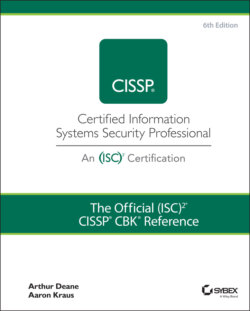Читать книгу The Official (ISC)2 CISSP CBK Reference - Leslie Fife, Aaron Kraus - Страница 32
Alignment of the Security Function to Business Strategy, Goals, Mission, and Objectives
ОглавлениеAn effective security function must be in alignment with the company's business strategy, goals, mission, and business objectives. Each of these elements should be considered during the creation and management of the organization's information security program and policies.
Companies that fail to properly align their security program with their business strategy, goals, mission, and objectives often perceive security as a business blocker; these companies frequently experience information security as a hurdle that must be cleared to get things accomplished. On the contrary, an information security function that is tightly aligned with a company's strategy and mission can serve as a business enabler, where security is built into the fabric of the company and helps drive toward common goals and objectives. In other words, a company should achieve its mission thanks in part to security, not despite security.
A mission statement is a simple declaration that defines a company's function and purpose; a mission statement summarizes what the company is, what it does, and why the company exists to do those things. A mission statement should be used to drive all corporate activities, including the organization's allocation of time, finances, and effort.
A business strategy describes the actions that a company takes to achieve its goals and objectives. Whereas a mission statement describes what will be achieved, an organization's business strategy identifies exactly how the mission will be accomplished. A company's mission statement rarely changes, but an organization's strategy must be flexible enough to change as the business environment changes.
A goal, in business, is something that an organization expects to achieve or accomplish. Business goals help a company plan for success, and an organization's goals should contribute to its mission. Many companies use the SMART criteria to define their organizational goals. SMART is a mnemonic acronym that defines criteria for creating quality goals. A SMART goal must exhibit the following characteristics:
Specific: State what you will do using real numbers and real deadlines.
Measurable: Identify a way to evaluate progress and measure success (or failure). Use metrics or data targets to ensure that the goal is trackable.
Achievable or Attainable: Establish challenging, but possible, goals that are within your scope.
Relevant: Establish a goal that is pertinent to your overall mission and vision and aligned with your organization's values and strategy.
Time-bound: State when you will get the goal done, using specific dates or timeframes.
An objective is a milestone or a specific step that contributes to an organization reaching its goals and achieving its mission. Objectives are used to define incremental steps toward achieving a broader goal. Much like SMART goals, organizations often use the SMART framework to define quality objectives. While many people incorrectly use the terms goal and objective interchangeably, you should understand that an objective is a short-term milestone that supports a longer-term goal.
When establishing your organization's security function, you should begin by defining a security strategy that aligns with your organization's overall business strategy and mission statement. You should develop a set of specific, measurable, achievable, relevant, and time-bound goals and objectives that will help you efficiently maintain the confidentiality, integrity, and availability of your company's systems and information without disrupting your organization's ability to achieve its business goals and objectives. Running an effective security program demands careful consideration of business needs and organizational strategy, in addition to legal and compliance requirements, and requires governance to manage the effectiveness of the security function within the overall organization.
